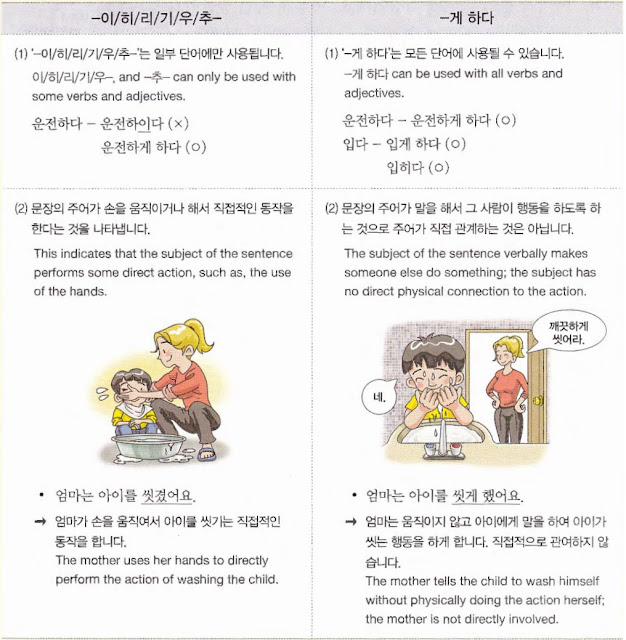 KIIP 3 (New book) – 8과: 음식과 요리 Food and cooking
KIIP 3 (New book) – 8과: 음식과 요리 Food and cooking
(Page 98)
1.
고추장: chili paste
간장: soy sauce
된장: fermented soybean paste
참기름: sesame oil
식초: vinegar
고춧가루: chili powder
깨: sesame
후추: pepper
2.
당근을 씻다: wash carrots
양파 껍질을 벗기다: peel onion skin
감자를 칼로 썰다: slice potatoes with a knife
마늘을 다지다: mince garlic
물을 끓이다: boil water
기름에 튀기다: fry in oil
만두를 찌다: steam dumplings
계란을 삶다: boil eggs
밥을 볶다: stir-fry rice
나물을 무치다: season vegetables
고기를 굽다: grill meat
시금치를 데치다: blanch spinach

A: Why is Jinju crying?
Me: My brother made Jinju cry
A: The baby is eating rice.
B: The mother is feeding the baby.
1. (Page 99)
이 링: 우리 아이는 채소를 잘 안 먹어서 걱정이에요.
안젤라: 그래서 저는 채소로 볶음밥을 만들어서 아이한테 먹여요.
이 링: I’m worried because our child doesn’t eat vegetables well.
안젤라: That’s why I make fried rice with vegetables and feed it to my child.
가: 아기랑 같이 산책하러 갈까요?
나: 네. 날씨가 좀 추우니까 옷을 따뜻하게 입히세요.
A: Shall we go for a walk with the baby?
B: Yes. The weather is a bit cold, so dress him warmly.
•겨울 코트 세탁은 세탁소에 맡기세요.
Leave your winter coat cleaning to the dry cleaners.
•저는 아이를 자동차 뒷자리에 태워요.
I put the child in the back seat of the car.
2. (Page 100)
라 민: 지금 차를 마시려고 하는데 같이 마실래요?
아나이스: 그럼 제가 물을 끓일게요.
라 민: I’m about to make tea. Would you like to have some together?
아나이스: Sure, I’ll boil the water then.
가: 남은 고기는 어떻게 할까요?
나: 냉동실에 넣어서 얼리세요.
A: What should I do with the remaining meat?
Me: Put it in the freezer and freeze it, please.
•음악 소리가 너무 크니까 소리를 좀 줄여 주시겠어요?
The music is too loud, could you turn it down a little?
•음식이 맛있어서 남기지 않고 다 먹었어요.
The food was so delicious that I ate it all without leaving anything.
말하기 (Page 101)
후엔: 제가 요즘 속이 좋지 않아 밥을 못 먹는데 어떤 음식을 만들어 먹으면 좋을까요?
고천: 소화가 잘 되는 야채죽은 어때요? 요리하기도 아주 쉬워요.
후엔 : 어떻게 만들어요? 좀 가르쳐 주세요.
고천: 먼저 밥에 물을 넣고 끓인 다음 채소를 썰어 넣고 끓여요.
후에: 얼마나요?
고천: 큰 채소가 익을 때까지 끓이면 돼요. 오래 걸리지 않아요. 간단해요.
후엔 : 우와! 생각보다 어렵지 않네요. 집에서 만들어 먹어야겠어요.
고천: 그래요. 만들다가 모르는 게 있으면 언제든지 저한테 물어보세요.
Huen: I haven’t been feeling well lately and couldn’t eat, what kind of food would be good for me to make and eat?
Gocheon: How about vegetable porridge that is easy to digest? It’s very easy to cook too.
Huen: How do you make it? Please teach me.
Gocheon: First, add water to the rice and boil it, then add sliced vegetables and boil them.
After: For how long?
Gocheon: Just boil it until the larger vegetables are cooked. It won’t take long. It’s simple.
Huen: Wow! It’s not as difficult as you think. I need to make it at home.
Gocheon: Yes. If you don’t know anything while making it, feel free to ask me.
듣기 (Page 102)
후 엔(여): 제이슨 씨, 어제 회식은 어디에서 했어요?
제이슨(남): 우리 회사 앞에 새로 생긴 고기 뷔페에서 했어요.
후 엔(여): 고기 뷔페요? 한 번도 안 가 봤는데 뷔페면 다양한 고기를 다 먹어 볼 수 있겠네요.
제이슨(남): 네, 돼지고기, 소고기 말고도 고기 종류가 정말 많았어요. 떡볶이, 볶음밥, 과일 같은 음식도 있었고요.
후 엔(여): 우와! 저도 고기를 좋아하는데 가 보고 싶네요. 저는 간장 양념된 고기를 좋아하거든요.
제이슨(남): 다음에 우리 반 회식할 때 거기 갈까요? 제가 고추장, 된장, 다진 마늘, 고춧가루로 맛있는 소스를 만들어 줄게요.
후 엔(여): 생각만 해도 군침이 도네요.
후 엔(여): Jason, where did you have the dinner gathering yesterday?
제이슨(남): We had it at the new barbecue buffet in front of our company.
후 엔(여): A barbecue buffet? I’ve never been there, but if it’s a buffet, you can try various types of meat.
제이슨(남): Yes, there were a lot of meat varieties other than pork and beef. There were also foods like teokbokki, fried rice, and fruits.
후 엔(여): Wow! I also like meat, so I want to go. I particularly like soy sauce-marinated meat.
제이슨(남): Should we go there for our next team dinner? I’ll make a delicious sauce with gochujang, doenjang, minced garlic, and chili powder.
후 엔(여): It makes my mouth water just thinking about it.
뷔페: buffet
군침이 돌다: mouth-watering
발음: 
읽기 (Page 103,104)
1.
뿌리다: to sprinkle, to scatter
소스를 뿌리다: to drizzle sauce
후추를 뿌리다: to sprinkle pepper
깨를 뿌리다: to sprinkle sesame seeds
썰다: to slice, to cut
채를 썰다: to slice into strips
얇게 썰다: to slice thinly
깍둑썰다: to slice in round pieces
담다: to put, to contain
통에 담다: to store in a container
접시에 담다: to put on a plate
그릇에 담다: to put in a bowl or dish
맞추다: to adjust, to aim
간을 맞추다: to adjust the seasoning, to balance the flavor
양을 맞추다: to adjust the quantity
시간을 맞추다: to set the time
2.
재료
김치, 양파, 참기름, 설탕, 부침 가루
방법
① 김치와 양파는 얇게 썰어 준비하세요.
② 준비된 재료의 양에 맞춰 부침 가루 2컵에 1컵을 넣어 잘 섞어 주세요.
③ 프라이팬에 부치고 접시에 예쁘게 담으세요.
Ingredients:
Kimchi, onions, sesame oil, sugar, pancake mix
Instructions:
① Slice the kimchi and onions thinly.
② Adjust the amount of pancake mix to match the prepared ingredients. Mix 2 cups of pancake mix with 1 cup and mix well.
③ Fry the mixture in a pan and neatly place it on a plate.
재료:
고추장, 사과 식초, 다진 마늘, 참기름, 고춧가루, 비빔국수면
방법:
① 국수를 4분 정도 삶고 물을 빼세요.
② 국수에 상추, 깻잎을 채 썰어 넣고 양념 재료를 넣고 비비세요.
③ 완성되면 그릇에 담고 삶은 계란을 잘라 위에 놓으세요.
Ingredients:
Gochujang, apple vinegar, minced garlic, sesame oil, red pepper powder, cold noodles
Instructions:
① Boil the noodles for about 4 minutes and drain the water.
② Slice lettuce and perilla leaves and add them to the noodles along with the seasoning ingredients and mix well.
③ Once done, place it in a bowl and top it with boiled eggs.
3.
둘이 먹다가 하나가 죽어도 모르는, ‘김치볶음밥’!
오늘 반찬이 없나요? 걱정하지 마세요. 누구나 좋아하는 ‘김치볶음밥’을 만들어 봅시다.
◆ 재료: 김치, 밥, 계란, 양파, 당근, 돼지고기, 식용유, 고춧가루, 설탕, 간장, 참기름, 깨
(집에 있는 재료만 넣어도 됩니다.)
◆ 방법
① 양파, 당근은 작게 깍둑썰기를 한다.
② 채소의 양에 맞춘 김치는 먹기 좋은 크기로 썬다.
③ 프라이팬에 식용유를 두르고 돼지고기를 먼저 볶는다.
④ 돼지고기를 볶은 후 양파, 당근을 넣고 볶는다.
⑤ 양념(설탕, 간장, 고춧가루)을 넣고 볶다가 김치를 볶는다.
⑥ 2~3분 뒤 밥을 넣고 볶으면서 간을 맞춘다.
⑦ 완성된 볶음밥을 접시에 담고 계란프라이를 부쳐서 밥 위에 올린다.
⑧ 참기름, 깨를 뿌린다.
⑨ 맛있는 볶음밥 완성!
‘Kimchi fried rice’ that two people won’t even know if one of them dies!
Do you have no side dishes today? Don’t worry. Let’s make the universally loved ‘Kimchi Fried Rice’.
◆ Ingredients: Kimchi, rice, eggs, onions, carrots, pork, cooking oil, red pepper powder, sugar, soy sauce, sesame oil, sesame seeds (You can use the ingredients you have at home.)
◆ Instructions
① Finely slice the onions and carrots.
② Slice the kimchi to a size that is easy to eat, according to the amount of vegetables.
③ Heat cooking oil in a frying pan and stir-fry the pork first.
④ After stir-frying the pork, add the onions and carrots and continue stir-frying.
⑤ Add the seasoning (sugar, soy sauce, red pepper powder) and continue stir-frying, then add the kimchi and continue stir-frying.
⑥ After 2-3 minutes, add the rice and continue stir-frying while adjusting the seasoning.
⑦ Put the finished fried rice on a plate and fry an egg to put on top of the rice.
⑧ Sprinkle sesame oil and sesame seeds.
⑨ Delicious fried rice is complete!
두르다: to coat, to spread (To spread oil on the surface of a pot or pan.)
볶다: to stir-fry, to fry
부치다: to fry

식품의 유통 기한 – Expiration date of food
‘유통 기한‘은 판매자가 식품 등의 제품을 소비자에게 팔 수 있는 날짜를 말한다. 이 날짜가 지나면 상하지 않은 제품도 더 이상 판매할 수 없다. 이러한 유통 기한은 년, 월, 일로 표시하는데 식품에 따라서는 시간까지 표시를 하기도 한다.
그런데 최근에는 제품에 유통 기한과 함께 소비 기한을 표시하기도 한다. ‘소비 기한‘은 유통 기한이 지나도 일정 기간 이후까지 우리가 음식을 먹을 수 있는 날짜를 말한다. 소비 기한은 제품에 따라서 18개월 이상도 가능하기 때문에 보관 방법을 잘 지킨다면 유통 기한이 지난 음식을 아깝게 버리는 일을 줄일 수 있다. 다만 올바른 방법으로 보관하지 않으면 유통 기한 이내에도 식품은 변할 수 있다는 사실을 꼭 기억해야 한다.
The term ‘유통 기한’ refers to the date until which a seller can sell a product like food to consumers. Once this date has passed, even products that have not spoiled cannot be sold any longer. This distribution date is indicated in years, months, and days, and in some food products, the time is also indicated.
However, recently, products have also been labeled with a ‘소비 기한’ along with the distribution date. The ‘소비 기한’ refers to the date until which we can consume the food even after the distribution date has passed. As the ‘소비 기한’ can be more than 18 months depending on the product, if the storage method is well maintained, it can reduce the waste of food after the distribution date. However, it should be noted that if not stored properly, food can spoil even within the distribution date.
유통 기한: expiration date
상하다: to spoil, to go bad
표시하다: to mark, to indicate
소비 기한: shelf life
가능하다: to be possible, to be capable
아깝다: to be a waste, to be regretful
변하다: to change, to transform
Vocabulary
고추장: chili paste
간장: soy sauce
된장: fermented soybean paste
참기름: sesame oil
식초: vinegar
고춧가루: red pepper powder
깨: sesame seeds
후추: pepper
당근을 씻다: wash carrots
양파 껍질을 벗기다: peel onion
감자를 칼로 썰다: slice potatoes with a knife
마늘을 다지다: mince garlic
물을 끓이다: boil water
기름에 튀기다: fry in oil
만두를 찌다: steam dumplings
계란을 삶다: boil eggs
밥을 볶다: stir-fry rice
나물을 무치다: season vegetables
고기를 굽다: grill meat
시금치를 데치다: blanch spinach
토끼: rabbit
유모차: stroller, pram
냉동실: freezer
죽: porridge
익다: ripe, cooked
믹서기: blender
환자: patient
이유식: baby food, weaning food
뷔페: buffet
군침이 돌다: to salivate, to make one’s mouth water
뿌리다: sprinkle
채를 썰다: slice into strips
얇게 썰다: slice thinly
깍둑썰다: slice in round pieces
절이다: pickle
담다: store, put in
간을 맞추다: adjust the seasoning
양을 맞추다: adjust the quantity
식용유를 두르다: coat with cooking oil
시간을 맞추다: synchronize time
부침가루: bread crumbs
부치다: fry
둘이 먹다가 하나가 죽어도 모르다: “Kimchi fried rice is so delicious that you wouldn’t even notice if one person dies while the two are eating.” (Korean idiom emphasizing the incredible taste and satisfaction of the dish)
– KIIP 3 translated in English (사회통합프로그램): Click here
– KIIP 3 Grammar (사회통합프로그램): Click here
– KIIP 4 쓰기 (사회통합프로그램): Click here
– KIIP 5 쓰기 (사회통합프로그램): Click here
